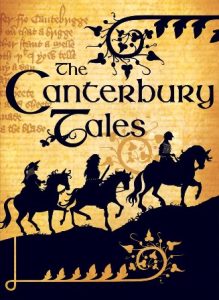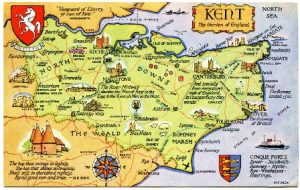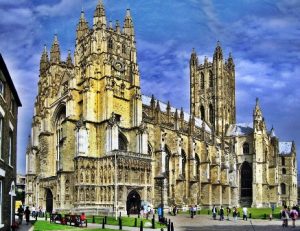
I hadn’t given this corner of England much thought as being Celtic, but it turns out that back in the so-called Iron Ages a loosely knit Celtic tribe known as the Cantiaci or the Cantii called this corner of Southeast England their home. Their lives were rudely interrupted by the Romans in 43 AD and things were never quite the same. But this Celtic connection was enough to prompt me to explore this “Garden of England” – a region I had never had a chance to get to know.
Thus it was that on a mild spring day my wife Linda and I found ourselves driving the M20 away from London to a green and generous land well suited for some good hiking, cultural exploration, literary inspiration and authentic British ale. As we arrived at our destination, a tiny village named Stelling Minnis, I envisioned the Cantiaci of ancient times living a good life in such a paradise, where this fertile land could certainly provide all you ever needed for quiet rural existence.
Mistletoe Cottage was located down a narrow single-track road through horse pastures and horse chestnut trees. It was smaller than expected, but inviting in every other way. It seemed that every plant on the premises had decided to bloom that week so that made up for the cramped quarters. It was somewhat chilly that first night and the primary source of warmth in the place seemed to be a heated towel rack in the bathroom, although the place had the most effective on-command hot propane hot water heater I’d ever seen. It was perhaps the first time in the U.K. I’d ever taken a shower without it ending in a cold drizzle.
Canterbury was just twenty minutes away and we soon made our first foray into that legendary city. I had read the full Canterbury Tales in the original Middle English in graduate school and found the author – Geoffrey Chaucer – most entertaining, mischievous and insightful. The stories in the work were told by fictitious pilgrims on their way to Canterbury in the fourteenth century. So ours was a pilgrimage to ascertain what those pilgrims were seeking.

Somewhere along the way I discovered that Geoffrey Chaucer himself probably never once set foot in the town. On our drive into the city, however, I noted that a housing development, a regional hospital and a skateboard park bore his name, and I was pleased to see him immortalized thus.
In my reading of the tales during an academic year – burdened with tedious British texts obsessed with manner and custom – I had much appreciated Chaucer’s wit, his wacky characters and his emphasis on love, sex and general good cheer.
And so, why exactly were these good folk on their way to Canterbury in those days of old? Well, St. Augustine came here in 597 to bring Christianity to England. In 1170, the highly revered Thomas Beckett was murdered here after a conflict with the crown over the rights of the church. According to Eyewitness to History, “A sword’s crushing blow extinguished the life of Thomas Becket, Archbishop of Canterbury, on a cold December evening as he struggled on the steps of his altar. The brutal event sent a tremor through Medieval Europe.”And thus, years later, the pilgrims began arriving for spiritual renewal.
About 44,000 people live in Canterbury today but, upon our arrival, the old part of town was mostly overburdened with tourists as it was a weekend. So we cantered away in our rental car, and decided to visit the cathedral later that week. I chose the verb “canter” because the locals had once upon a time used the phrase “Canterbury trot” to describe the way the pilgrims would ride upon their horses as they headed to town. This phrase was later shortened to “canter” and horsey people still use it to this day.
Far from the madding crowds the next day, we sought out the backest of back roads exploring tiny villages like Stouting Common, Whatsole Street and West Braebourne on our way to Wye. Along the way we stumbled upon a hiking trail above Hastingleigh Downs and found ourselves at a look-off where the sign modestly boasted that it was “Possibly the Best View in Kent.” Below us was the England of my dreams and, for the most part, the view would have been much the same as it was in the eighteenth century; hills, farms, stone houses, tiny villages, endless trees and rolling hills. The only anomaly seemed to be an array of gleaming white buildings that looked like a space station on the westerly horizon. It seemed alarmingly out of kilter and we determined to find out what it was later that week.
Wye was one of those little rural English towns that make you want to abandon North America and settle here into a quiet tranquil life of porridge breakfasts, morning tea, crossword puzzles, crustless sandwich lunches, afternoon tea with scones and an early evening pruning of your prize roses. Alas, I would not survive a day of it. But such thoughts run through my mind. Linda and I made a familiar tour of a church graveyard. The older gravestones had been “polished by time” and the names and dates were worn off by the years. I surmised that the towering chestnut trees in full blossom were not as old as most of the souls planted in the soil here. I like old graveyards immensely and grieve slightly that I’ll eventually be interred in a country so (technically) young as 150 years.

On another fine day, we made a beeline for the Channel coast to hike the trails above the cliffs of Dover. My father, who had been a war veteran stationed in England, sometimes played cassette tapes with WWII music and I remember listening to Vera Lynn sing,
“There’ll be bluebirds over
The white cliffs of Dover
Tomorrow
Just you wait and see
I’ll never forget the people I met
Braving those angry skies
I remember well as the shadows fell
The light of hope in their eyes.”
He’d planted images in my head of Allied bomber pilots, their planes riddled with bullets and their engines smoking, struggling to keep their planes aloft over the English Channel. They were praying out loud that the next second those stark white and oh-so-hopeful cliffs would appear in sight.
I’ve never been disappointed by any form of coastal hiking in the U.K., and the Dover cliffs were as good as it gets. (We skipped both the castle and the town – probably my doing.) The views were magnificent, although it was not clear enough to see the French shore. Once past the parking lot and the gift shop, the grassy fields and trails are more or less untainted despite the thousands who visit here each year. The wind was high and the hikers were mostly old folks with walking sticks that made them look like skiers without skis. We all had runny noses and reddish cheeks from the cold, salty breeze, which made it easy for us to look like locals rather than tourists from abroad.
I don’t know exactly how we got somewhat lost, but we did as there were several different levels for walking. I asked some directions from another a pair of hikers who turned out to be German and they sent us in the perfectly wrong direction. It could have been they misunderstood my question, but nonetheless it added an extra couple of kilometers to our jaunt so I reckon it was good for our health.

After we finally found our way back to our car, we headed to the seaside town of Deal but it reminded us too much of those British coastal towns like Bridlington and Brighton where inland city dwellers flock in the summer to stake out territory on crowded pebbly beachesbefore turning their skin beet-red in the sun. Sandwich was a fair bit more quaint and interesting. And, yes, it really is the place of origin of theubiquitous word we use today for anything involving two slices of bread – thanks go to John Montagu, the fourth Earl of Sandwich. We wandered around the shops and twisty streets until we were lost yet again. Truth is, getting lost somewhere is usually the most fun to be had in many situations. We ended up on a path beside a small river or canal (I couldn’t decide which). My wife doesn’t like me to ask for directions from anyone. Her belief seems to be that we should be able to find our way with our own wits. And hadn’t the Germans sent us hoofing on the wrong path? But, my legs were giving out, so I asked for help from one of those know-it-all old British coots who must have been dragging himself home from an afternoon at the pub.
He looked me up and down as if he thought I was a terrorist, or at least a Russian spy.
“Where are you trying to go?” he asked.
I explained we were trying to get to the car park near the quay – though I had pronounced quay as “kay.” His response was that the word was “key” not “kay” and that we were walking in the wrong direction. Then he added, “You couldn’t possibly be further away from your destination.” This made it sound like I was a buffoon and hopelessly lost. He pointed in three possible directions we could take to the “key” as Linda elbowed me, so I thanked him and we just kept walkingin the direction we had been going in only to discover the car park was a mere eight minute walk away.
My wife has a device on her cellphone that tells you how many steps you’ve walked in a day, what the total distance is and how high up or down you’ve gone. By the time we’d finished with Dover and Sandwich, we had logged many thousands of steps, 10.5 kilometres and gone up (and down) 30 stories.
We slept soundly that night and woke to sunlight and singing birds the next morning – something straight out of a Romantic poet’s sonnet.
 Our landlady had given us free tickets to Leeds Castle so I decided to drive the backroads there rather than the M20. This, however, took us first through Ashford, where my wife purposely conspired to lead us to the Ashford Designer Outlet shopping centre. This turned out to be that very strange and otherworldly set of buildings I’d spotted from the look-out over the Downs. It is a somewhat hideous North American styled collection of, well, outlet stores for every brand name of fashion or gobbledegook you’ve ever heard of. Ashford is probably the poster-child city for why someone would NOT want to go to England.
Our landlady had given us free tickets to Leeds Castle so I decided to drive the backroads there rather than the M20. This, however, took us first through Ashford, where my wife purposely conspired to lead us to the Ashford Designer Outlet shopping centre. This turned out to be that very strange and otherworldly set of buildings I’d spotted from the look-out over the Downs. It is a somewhat hideous North American styled collection of, well, outlet stores for every brand name of fashion or gobbledegook you’ve ever heard of. Ashford is probably the poster-child city for why someone would NOT want to go to England.
However, we were here and we made the rounds. The place was mobbed with what I assumed to be British families whose dream it was to live in places like Teeneck, New Jersey or Columbus, Ohio. The Gap was doing a brisk business, as was Tommy Huffinger or whatever his name is. People were almost frantically grabbing for goods. I checked the price tags of various items while my wife inspected some rather torturous looking shoes. As far as I could tell, the sales game was thus: first print a price tag with a sum three times what the item is worth. Then take a marker and mark it down not once but twice until the “sale” price (40-50% off) is only 10- 20% more than what the item could possibly be worth. And then wait for the hordes to descend and purchase.
The London Daily Express states that England has been invaded 73 times since 1066. Many of those invasions took place here in Kent. Clearly the Outlet Store Invasion was the most recent. We had a not-so-bad lunch at Chinese restaurant, and I drove as fast as the backroads would allow on towards Shadoxhurst, Woodchurch, past the South of England Rare Breeds Centre and on to bucolic Tenterden, known for its steam railway. I should note that it also made national news in August of 2013 when it announced that it was the first town in the U.K. to put up its Christmas lights.
There was a crisis underway in the carpark and I walked right into it as I went to get my ticket at the pay station. Two gentlemen were cursing the machine and a woman was wringing her hands. It appeared that the machine was not working. I wondered how I could help.
The most elderly of us suggested it was “bloody awful” and that we should all just leave angry notes on our windscreens about the faulty machine and the blight of politicians. But no one seemed to have a pen. No one but me, that is. I am a writer, after all, and dread the times when inspiration will burst upon my cranium like a solar flare and I find myself with no writing instrument. Now I’d saved the day. We all wrote our notes, although mine had no political commentary. And that was bloody that.

I don’t remember much else about the town except for a very lovely church called St. Mildred’s. St. Mildred, in case you didn’t know, was an eight century abbess from Kent whose remains ended up in Canterbury.
Then it was on to Leeds Castle, which was once the home of Catherine of Aragon in the sixteenth century.
The grounds were exquisite and the castle was opulent, a reminder of what people might do if they have a prodigious amount of wealth and unlimited manpower.
The two things I found most interesting, however, was the maze and the dog collar museum. The maze was a series of high hedges. The man outside said it would take us twenty minutes. After twenty minutes of taking all the wrong paths, however, we were no closer to finding out way out. I had mistakenly thought we could leave the way we came in but I couldn’t locate our entrance. Finally, I asked some visiting Belgian students if they could help us and they led us to a small Disney-like cave underground that was the key to freedom.
And yes, there really was a dog collar museum on the property at Leeds Castle. It had never occurred to me that nearly everything under the sun, even dog collars, probably has a museum somewhere on the planet. Suffice it to say, the collars were fascinating and bizarre, all of them far more elaborate and complex than the one we use on our little Westie at home,
On our final outing, we headed to the coast to the north, the wide mouth of the Thames. We hit Hearne Bay and Whitstable, both a tad too Brighton-like for our liking, before retreating south for our final pilgrimage to Canterbury on a sunny afternoon. There were Belgian and French students milling about as we entered the Cathedral and lit a candle in honour of our much loved deceased parents. Whatever your religion, a cathedral invokes a feeling of spiritual depth, and this one certainly did the job.

It was built between 1070 and 1180 and more construction happened from 1379- 1503. Obviously it was an inter-generational project. An earlier version of the cathedral was “burned and rebuilt” on a number of occasions. There are tombs inside with the remains of Henry IV and someone known as the Black Prince (possibly a Harry Potter character?). The Germans used the cathedral for target practice several times in WWII.
The bombing of historically significant buildings later became known as the Baedeker Bombings. It would appear that, at more than one point in the war, both sides started bombing monuments as well as historical and sacred buildings. How that can help win any war is beyond my scope of understanding. But then again, so is much of history.
Search as I did, I couldn’t find a significant remnant of Cantiaci culture in rural or urban Kent. These people who had this wonderful patch of earth to themselves for so many ancient years were invaded, conquered, and beaten, but eventually melded into the ethnic fabric of Kent and mostly lost to the proverbial mists of time. But I’m fairly certain I could feel the spirit of these ancient ones, as I shared the vision looking out over the Downs and sitting in pews above the stone floor of Canterbury Cathedral.
And since Chaucer had drawn us here, perhaps he should have the final say (translated to modern English). As a surfer, I’ve quoted him many times: “Time and tide wait for no man.” I’m sure you’ve heard that before as well. But he also wrote, “Women desire six things: they want their husbands to be brave, wise, rich, generous, obedient to wife, and lively in bed.” Listen up, gents – it is the wisdom of the ages.
~Story by Lesley Choyce




















Minster-On-Sea is well worth a visit – one half is a village, near it’s train station – then up the hill to a very modern resort of hotels and motels etc.